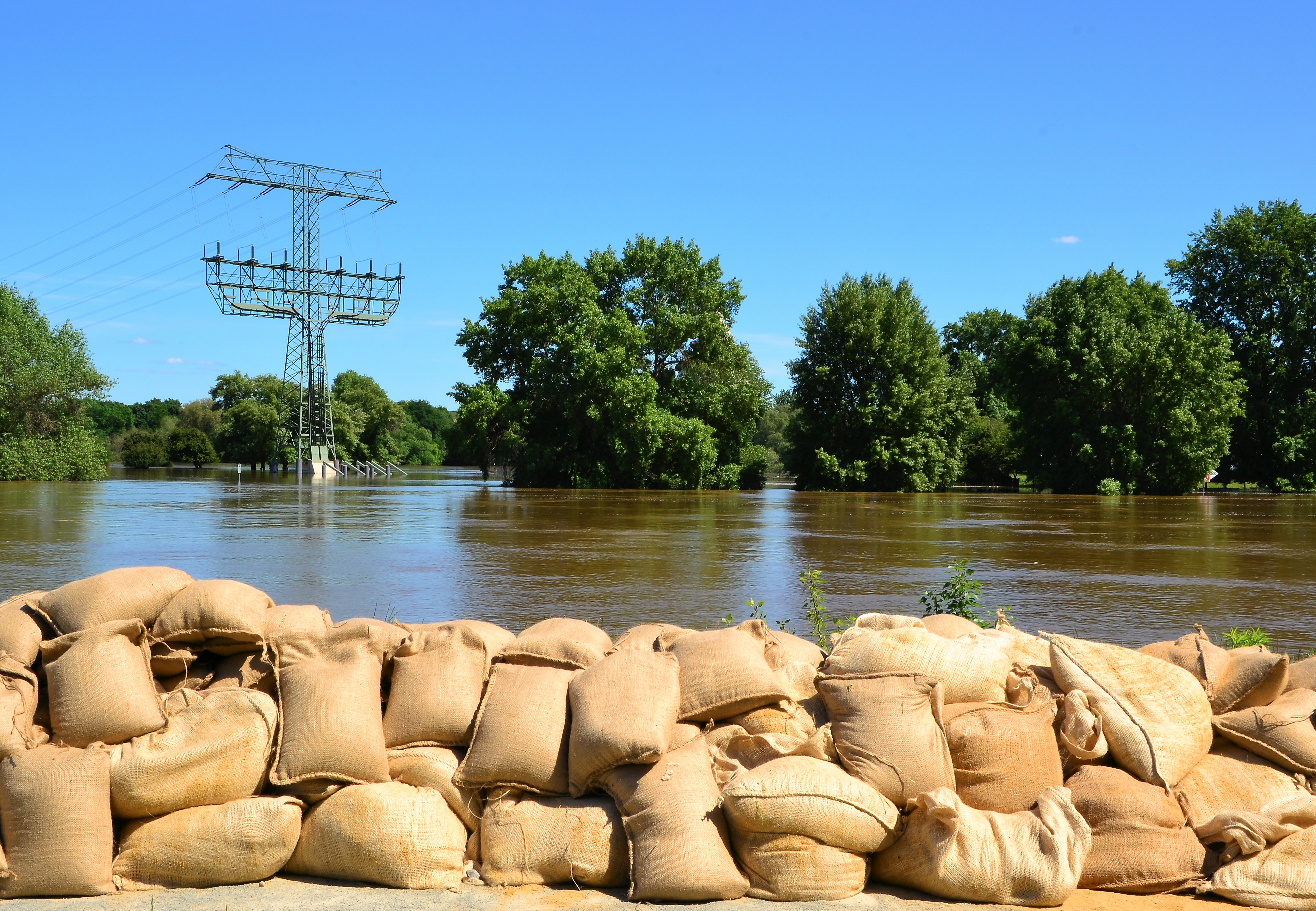How to use sandbags to protect your home from flooding

Sandbags correctly placed in appropriate locations around your home or business can reduce the impact of flooding.
They will not stop the water completely but can reduce the amount of water entering your property.
Where do I put the sandbags?
For most buildings, sandbags should be placed over floor wastes and drains (e.g. laundry, shower and bath) to prevent backflow of grey water entering. Sandbags should also be used in front of doorways, roller doors and brickwork vents.
Most standard homes and buildings on a concrete slab can be protected with less than 25 sandbags.
It is not always necessary to place a sandbag wall around your whole building to provide protection.
This may only be necessary if it is on stumps or constructed of materials such as timber or fibro sheeting.
Before building a sandbag wall, consideration should be given to how you would remove floodwater that could become trapped between the sandbag wall and your building. (e.g. pump, siphon or bailing bucket).
Where can I get sandbags from?
Sandbags can be purchased from some hardware stores or landscaping suppliers. During times of flood and storm, quantities may be distributed by local councils. Contact your local council or visit their website for information.
When significant flooding occurs, sandbags maybe in limited supply and may only be issued by the council or State Emergency Service (SES) on a case-by-case basis. So, be prepared and prepare your own sandbags before a potential flood event.
Self-inflating sandbags (ready-to-use sandbags that don’t require filling) are a lightweight alternative to traditional sandbags. They will self-inflate when they come into contact with water and can be stored a long time. Self-inflating sandbags can be purchased from some hardware stores or landscaping suppliers.
How do I fill the sandbag?
It is preferable that you only use sand to fill the bags. Soil, clay, gravel or a mixture of these is not usually recommended.
Sandbags only need to be filled to two-thirds full.
Do not overfill as they will be too heavy to carry. A filled sandbag can weigh 15-20kg.
Do not tie the top of the bag. The top of the bag may be tied for transport purposes only.
How do I lay sandbags?
Place down a layer of plastic sheeting to act as the water proofing membrane.
Lay sandbags like brickwork on top of the plastic sheeting.
Start at one end and work to the other end.
Ensure the unfilled top part of the bag is covered by the next bag.
Tuck flap under the bag at the end of the row.
Stagger rows so that the joins do not line up.
Where do I place the sandbags?
Place a small sandbag wall across doorways. The number of layers required will be dependent on the expected flood height, however it is generally about two sandbag rows high.
Make sure that you have at least one doorway that you can use to access or exit the building – do this by building a wall that allows the door to still be opened.
Air vents between brickwork may also require sandbags. Small vents may be covered with waterproof tape or plastic.
Cover all drainage holes and floor drains to stop backflow of contaminated water.
Protect air vents or drains with sandbags or tape. To avoid back flow of grey water block toilets with a small plastic bag of sand, weighed down by a larger sandbag.
What else can I do to protect my home or business?
Raising valuables off the floor may prevent damage to personal items from floodwater that may still enter.
Lifting of curtains, rugs and bedding, and removing items from low cupboards may be necessary.
Turn off power and gas at the mains.
For other ways to protect your home and family during a flood contact your local council or SES and visit their web sites for further information.
What do I do once I have finished with the sandbags?
Sandbags that have been exposed to floodwater need to be thrown away.
Care should be taken when handling wet sandbags; sturdy gloves should be worn as floodwater can contain chemicals, harmful waste and contaminates.
Sandbags should not be reused if they have been in contact with floodwater.
Sand from used sandbags, not exposed to floodwater or other contaminants can usually be scattered on laws or gardens as topsoil, where it will not wash into stormwater drains.
Contact your local council for advice on how you can dispose of contaminated sandbags.
For more information on sandbagging visit the State Emergency Service website.
Be prepared for extreme weather
Related topics
Things to note
The information in this article has been prepared for general information purposes only and is not intended as legal advice or specific advice to any particular person. Any advice contained in the document is general advice, not intended as legal advice or professional advice and does not take into account any person’s particular circumstances. Before acting on anything based on this advice you should consider its appropriateness to you, having regard to your objectives and needs.
Insurance Products (excluding Travel Insurance) are issued by RACQ Insurance Limited ABN 50 009 704 152 (RACQI) and arranged by its agent, RACQ Distribution Services Pty Ltd (RDS) ABN 35 116 361 650, AFSL 567130 and RDS' authorised representatives (including RACQ Operations Pty Ltd ABN 80 009 663 414, AR No. 234978 (RACQO). Conditions, limits and exclusions apply. RDS and RACQO are in the RACQ group of companies. One of the companies in the RACQ group of companies has a minority shareholding in RACQI.
RDS and RACQO have not taken your personal objectives, circumstances or needs into account when preparing advice regarding insurance products and you will need to consider whether the advice is appropriate for you. Read the Product Disclosure Statement (PDS) and any applicable Supplementary PDS before making a purchase decision on this product. You can also access our Target Market Determinations on this website. RDS receives a commission from RACQI for the policies it arranges. RACQO receives fees paid for services it provides to RDS. Further details about remuneration are available on request prior to purchasing.
Banking and loan products issued by Members Banking Group Limited ABN 83 087 651 054 AFSL/Australian credit licence 241195 trading as RACQ Bank. Terms, conditions, fees, charges and lending policies apply. This is general advice only and may not be right for you. This information does not take your personal objectives, circumstances or needs into account. Read the disclosure documents for your selected product or service, including the Financial Services Guide and the Terms and Conditions, and consider if appropriate for you before deciding.
Except for RACQ Bank, any RACQ entity referred to on this page is not an authorised deposit-taking institution for the purposes of the Banking Act 1959 (Cth). That entity’s obligations do not represent deposits or other liabilities of RACQ Bank. RACQ Bank does not guarantee or otherwise provide assurance in respect of the obligations of that entity, unless noted otherwise.
RACQ Bank subscribes to the Customer Owned Banking Code of Practice which establishes higher standards than the law requires. The Code reflects modern consumer expectations and developments in approaches to issues such as consumer vulnerability, guarantors, and supporting customers through financial hardship. Please read our Customer Owned Banking Code of Practice page for more information.
RACQ Operations Pty Ltd (ABN 80 009 663 414 AR 000234978) and Members Travel Group Pty Ltd (ABN 45 144 538 803 AR 000432492) are acting as an Authorised Representative of the issuer of the insurance, Tokio Marine & Nichido Fire Insurance Co., Ltd. (ABN 80 000 438 291 AFSL 246 548). Any advice set out above is general in nature only, and does not take into account your objectives, financial situation or needs. Before purchasing any travel products, please consider the RACQ Travel Insurance Product Disclosure Statement (PDS) and the Target Market Determinations (TMDs) that apply to these products. Whilst the PDS outlines the Terms and Conditions of these products, the TMDs outline the intended class of customers that comprise the target market for these travel products. This will allow you to consider which products best suit your objectives, financial situation and needs and consider the products appropriateness to your personal circumstances. TMDs also outline matters involving the distribution and the review of these products. The PDS, Supplementary PDS and TMDs for each travel product can be found here.
